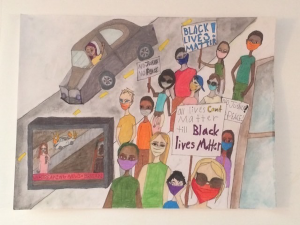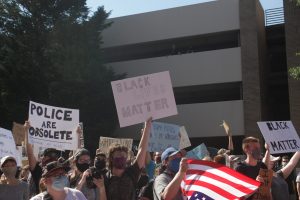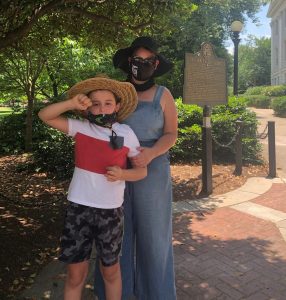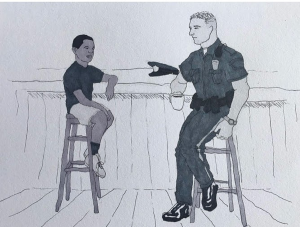Black Lives Matter versus the media

Black Lives Matter protests erupted on May 29 after the death of George Floyd and although many protests have been peaceful, there have been instances of riots. Clarke Central High School Class of 2020 graduate Saran Sesay believes the media has shed biased light on those riots. Illustration by Frances Thrasher
In recent days and weeks, inaccurate reporting and coverage of Black Lives Matter protests have become relentlessly in limiting the impact of the Black Lives Matter movement. Nightly news channels are filled with images of violent protests and looting. CNN and Fox News replay videos of rioters being arrested while police cars burn in the distance.
Quotes by Reverend Dr. Martin Luther King Jr. litter Facebook feeds, chastising young protesters for not following the path of nonviolence left by the civil rights icon. All of this has removed attention from the issue at hand and has been used to question the validity of the Black Lives Matter Movement.
America has always had a problem with seeing reality.
Our history books are distorted to tell the story of a democracy built on the principle that “all men are created equal.” Conveniently, these books forget to tell the parts of American history that totally go against that principle. The plight of the Native American people is completely ignored, and the history of American slavery is lightly touched but still, somehow treated as if it is inconsequential.
The misrepresentation of Black history creates an ignorance about Black struggles in America, so when issues like police brutality come up, a lot of times Black people are ignored and misunderstood. According to Pew Research Center, from July 12 2013 to March 31 2016 the hashtag Black Lives Matter was trending on Twitter. These issues are treated as if they do not exist and aside from a few trending hashtags and a weekend of reporting, everything goes back to normal.
America returns to a blissful ignorance about the experience of the other side, and the effects of systemic racism.
This past week has forced Americans out of their false sense of reality to see the injustices that still fester throughout the country. The Black Lives Matter movement has become stronger than ever before, and the support is international spanning from Europe to Asia, to South America and Australia according to a New York Times article; however, there has been an intense amount of negative coverage.
“This past week has forced Americans out of their false sense of reality to see the injustices that still fester throughout the country.”
This negative coverage dominated all types of media. Firstly, there was the criticism of rioting. On the first night of riots in Minneapolis, images of burning cars and buildings captivated the country. Photos of rioters clashing with police in fields of smoke and tear gas were plastered everywhere everyone could see. The news took these images and ran with them.
The rioters were judged as criminals and thugs from the start. Using the words of King, the effectiveness of these protests were put into question. These outlets focused on everything except the why. Why did people feel the need to riot? Their anger was portrayed as unjustified and irrational. This same biased coverage was used against looters. Looters’ intentions were called into question. News anchors ranted on air about looters taking advantage and distracting viewers from the true message of the movement.
Even the President joined in on Twitter to criticize the violence.
I can’t stand back & watch this happen to a great American City, Minneapolis. A total lack of leadership. Either the very weak Radical Left Mayor, Jacob Frey, get his act together and bring the City under control, or I will send in the National Guard & get the job done right…..
— Donald J. Trump (@realDonaldTrump) May 29, 2020
The focus strayed away from the issue, which was police brutality, to the argument about the correct way to protest. Again and again, the media has compared current protest to the past Civil Rights movement protest in the 1950s’.
They ignored the sources of anger and the exhaustion in the hearts of many people apart of this movement. The catalyst of the issue was ignored and instead, the focus turned to criticize the protester’s actions, effectively delegitimizing the anger and the outrage that had finally come to the surface.
“The catalyst of the issue was ignored and instead, the focus turned to criticize the protester’s actions, effectively delegitimizing the anger and the outrage that had finally come to the surface.”
The job of the media is to tell all sides of the issue. That job has always been important because the news is usually one of the few ways to get honest information about what is happening in one’s community.
The media articulates the different perspectives of the issue. That means their job isn’t to just show the peaceful protest during the day but to show the riots and the looting at night. Without displaying the full story, they have not done their job. Along with that, the media needs ratings and people are more attracted to images of violence than peaceful protest. The media is largely just doing their job; however, they are failing to report those sides without the influence of bias.
The violence that has occurred is a result of exhaustion in the hearts of many African Americans. The anger is specifically strong because many people feel unheard. The deaths of George Floyd and Breonna Taylor are not an isolated issue, but an effect of a systemic issue that remains unsolved. The portrayal of this anger as irrational and distracting by the media continues the legacy of America ignoring Black struggles and silencing Black voices.
The focus on the violence over peace creates an incomplete image of what is truly happening. A huge majority of protests were nonviolent and mirrored the protests seen during the Civil Rights Movement. The lack of coverage given to the peaceful side of protests is again giving an incomplete and biased perspective of what’s occurring. Without a complete idea of what is happening, it is more likely for Americans to question the legitimacy of the protests and criticize the actions of protesters. The criticism only perpetuates the issues at hand because there are fewer allies to join in the struggle.
The media could be more of an aid than a barrier in bridging American understanding of injustices against the Black community. It starts with giving a complete perspective and fair reporting. Complete perspective means changing the focus from action based negative reporting to community positive reporting. Community positive reporting focuses on the aspiration of community members and not just the struggles. Reporting in this manner would allow outside groups to get a better understanding of the issues in other communities that need fixing and what the goal is in these communities. Basing it on this would create more well-informed allies throughout the country and force Americans that for many years have been ignorant to issues outside of their communities to become educated and empathetic.
“The media could be more of an aid than a barrier in bridging American understanding of injustices against the Black community.”
Along with that, there should be a bigger focus on the cause of protests, not the reaction. Protests are done to bring awareness and force institutional change, but without a complete understanding of the reason for outrage it is a lot harder to solve these issues. Focusing on the cause helps people make judgments not simply based on emotions but based on knowledge.
Media is charged with a very hard, but important job to tell the whole truth about these protests. Biased coverage could have a catastrophic effect on the effectiveness of these protests to truly effectuate change, so it is on the media to be fair and thorough.
Downtown Athens Black Lives Matter protests

Protesters march to the University of Georgia Arch from the Athens Clarke County Court steps on May 31. Clarke Central High School class of 2017 alumna Aslea Eatenson, who attended the rally as a volunteer, believes that White allies to the movement should take an initiative to educate themselves on topics surrounding the movement. “I’m a White ally in support of my best friend, and I’m in support of all my friends and people of color. I think the major things I want to (say) are directed to White people: educate yourself (about the movement). There are so many resources available right now,” Eatenson said. Photo by Naomi Hendershot
On May 31, Athens community members and others from surrounding areas gathered at the Clerk of State & Superior Court steps and began the march to the University of Georgia Arch in protest of police brutality.
On May 31, in the heat of the recent resurgence of the Black Lives Matter movement, the Athens Mutual Aid Network along with local Black Athens activists organized and led a protest of around 2,000 people in correlation with the recent BLM rallies across the nation.
“The first purpose (of this protest) is collective mourning and righteous indignation for the recent incidents of police violence and racism that have happened in this country, as well as acknowledgment of a long history of systemic racism in both this country in the city,” Athens Clarke County District Two commissioner Mariah Parker said. “As a member of the County Commission, I am interested in how it can turn this righteous indignation into legislative action. And so members of Athens Mutual Aid Network, who were central to organizing this event, adopted some of my policy demands as key to the messaging of the event. We (are) sad. We want cops to stop killing us. We want justice for George Floyd, but we also want Athens to be better, and so we gathered to demand that.”
The protest began at the Clerk of State & Superior Court steps on 325 E. Washington St., where many gathered to begin the march to the University of Georgia Arch on East Broad St. Once at the Arch, many local Black activists, including Parker, gave testimonials in front of the “Soldiers’ Monument”.
“I am not personally familiar with everyone who came up to speak but I do know there were members of the Athens Mutual Aid Network, as well as I was there with a friend and fellow hip-hop artist, Celine Hayes, who spoke,” Parker said. “There (were) a number of mostly queer Black women that were leading and speaking from the Confederate monument on Broad Street, and it was exclusively Black people that we allowed to speak.”
Among those attending the rally, Clarke Central High School class of 2017 graduates and current UGA student Denise Sunta and current Barnard College student Alesa Eatenson were among the many volunteers who wore bright green armbands.
“The green armbands are worn by the protest marshals — our job was to make sure that protesters were following the march route and reminding folks that we were staging a peaceful protest,” Sunta said.
Although many protesters were gathered around the “Soldiers’ Monument”, some in attendance stayed towards the back of the crowds to practice social distancing while still participating in the rally.
“I wish there would be more social distancing, but I’m here in the back where there’s plenty of room, so I feel safe personally. I like how they’re handing out masks and hand sanitizer,” community member Morgan King said.
King hopes that protests like the one in Athens will make a difference.
“I just hope something changes. I hope this whole culture changes, and I hope that when people come together like this they realize that we have power,” King said. “We have power in numbers, and I don’t know who the President’s gonna be (come Nov. 3), I don’t know what’s gonna happen, but people need to realize that we have power when we come together.”
According to Sunta, protesters of different races were in attendance.
“I would say that the racial demographics of the protest, in general, were fairly mixed,” Sunta said. “I think given how racially segregated Athens actually is in some respects, (it) is indicative of how real and serious the issue of police violence and institutional racism is within our community.”
Although many in attendance may have viewed the event as progress for BLM, local Black activist and Community Organizer Imani Scott-Blackwell viewed the event’s effects differently.
“I just wanted to take in the irony of a peaceful protest saying, ‘No justice, no peace.’ I was curious to see how many people thought we were getting closer. I wanted to look at all of the potential changemakers and see how close they were to actually actively making changes,” Scott-Blackwell said. “My question is what happens tomorrow? You know, what happens when the next person is killed? Is there going to be the next person? Are we okay with that? And if not, what are we going to do for that?”
Scott-Blackwell also questioned the intent of some in attendance at the protest.
“I feel like it’s ironic because it’s almost as though we forgot that we just had a Black person murdered here in our state. We forgot that here in Athens, eight people have been murdered by the police in the last year,” Scott-Blackwell said. “And so now we all want to get together almost like taking this opportunity to — I could see a lot of people that have been trying to get out of the house, and this is about one of the only justifiable times to do so.”
Overall, Parker felt the day offered opportunities for peaceful shows of solidarity.
“I think it went incredibly. I think that people stood in solidarity together, in love and in a commitment to a more just world. We demonstrated our anger and our commitment to justice peacefully, which is the outcome everyone wanted, I believe,” Parker said. “There were two separate events, and we were able to merge very peacefully, come together and stand together, and a beautiful show of solidarity. And so I’m really proud of Athens and what we did yesterday.”
Guest writer: CCHS English department teacher Jennifer Tesler
Clarke Central High School English department teacher Jennifer Tesler stands with her son at the University of Georgia. Tesler believes it is important to protest police brutality in support of those who have lost their lives to it. Photo courtesy of Jennifer Tesler
On Saturday, June 6 in Athens, our community protested police brutality and historical oppression of Brown and Black bodies in our society. The National Guard arrived at noon to assist our local police force. The aim, to maintain peace. The night ended with tear gas and rubber bullets.
My son and I protested earlier that week in a gathering to support Black Lives Matter. We felt we needed to engage despite the risk of the virus. It was too important to not participate. We sat under the arches downtown with our masks on, in solidarity.
The oppression of, the rejection of, the invisibility of, the blaming of and disposability of Brown and Black bodies in our society is violence and results in death, most recently the deaths of George Floyd, Breonna Taylor, Ahmaud Arbury and now Rayshard Brooks.
No justice. No peace.
Before the 2020 school year ended prematurely, Clarke Central High School senior literature students engaged in projects where they thought deeply about ways that forces of oppression in our society have impacted their lives. If we allow ourselves to listen, we have much to learn from them.
America
What is white privilege
The American Image
Someone has been killed
Two suspects
The darker sentenced to life
While the white gets a slap on his wrist— By Cameran Daniel and Ashley Mendoza,
CCHS students
Put a finger down Challenge
Put a finger down if you have been called a racial slur
Put a finger down if you have ever dropped a class because you felt like you didn’t belong
Put a finger down if you ever been told “go back to your country”
Put a finger down if you have never learned about your race history without it being a specific month
Put a finger down if you have to depend on a sport for a scholarship
Put a finger down if you have ever been worried about paying bills
Put a finger down if you have ever been accused of stealing because of your looks— By Cameran Daniel and Ashley Mendoza,
CCHS students
The Wooden Table
The wooden empty table
Holding nothing but its weight
Not everyone is able
The risk,
The pain,
The bruises,
But why would you even bother?
You have nothing but a sense useless,
All you can do is pray to the holy father.— By Oscar Mejia,
CCHS student
Creating kinder communities
A young Black boy converses with a local police officer. Police officers should participate in community involvement training to meet the people they are protecting and reduce police brutality. Illustration by Lilli Sams
On May 25 in Minneapolis, Minnesota, George Floyd died while in police custody. Since this incident and other similar situations, protests regarding excessive use of force by the police have erupted across the nation.
While the issue is currently dominating the media, this topic has been prevalent in America for at least 50 years, but not enough has been done to correct it. The current law enforcement system needs reform.
According to the Proceedings of the National Academy of Sciences, “Police violence is a leading cause of death for young men in the United States. Over the life course, about 1 in every 1,000 black men can expect to be killed by police”
Police officers should be active members of their community before anything else. The motto “Protect and Serve” cannot be true to any police department until each and every officer is aware of who they are serving.
“Police officers should be active members of their community before anything else.”
Having a mandatory course in de-escalation training for every officer can be the beginning of that reform. Deescalation training is a form of training created to teach police officers how to handle a situation with little to no violence while also reducing the risk of the apparent scenario.
According to American Public Media, only 21 states require this training for their officers. Locally, Georgia only requires one hour of this training. The states who require this training have reported some of the lowest amounts of police-related violence in recent years. Las Vegas, Nev. saw their use of force complaints cut by more than half.
Further, American citizens should broaden the scope of what de-escalation training means. When everyone involved is familiar with one another it is easier to avoid unnecessary violence. Thus, a further step that should be taken is mandatory community involvement from every officer.
“In order for law enforcement to be truly effective, police agencies cannot operate alone; they must have the active support and assistance of citizens and communities.” Elgin, Ill. Police Department Sergeant Eric Echevarria wrote on the IACP website
A Black man is out celebrating New Year’s Eve at around 2 a.m. when he is stopped by the police and questioned. Even though he is completely compliant, the situation escalates and the man is eventually shot in the back by police. Instead of helping the man with immediate first aid, he is handcuffed and neglected treatment as he dies. Sadly, this is not an imaginary situation. This is real life, this is how Oscar Grant died.
In order to prevent more situations like this, police need to be familiar with their community and its members.
“In order to prevent more situations like this, police need to be familiar with their community and its members.”
Now, consider a situation in which both parties are familiar with each other and the officer knows the individual from their community involvement, they may now be aware of the underlying facts that might put this individual in this place at this time. The situation is more likely to end without conflict and without the officer making a decision based on prejudice.
One may argue that this training is expensive and time-consuming, due to calling in specialists to provide the training and that community involvement takes up valuable time that could be used to have more officers working in the streets. That without these officers readily available, emergencies may take longer to reach, causing possible chaos.
However, according to USA Today, the majority of police training time is spent working with firearms. Some stations reported spending up to 58 hours in a month on using these weapons, but the same stations reported as low as 10 hours in communication and de-escalation technique training.
Understandably, firearms are a powerful tool and require detailed training to be handled properly. However, if we provide training to these officers on how to not let a situation spiral out of control, they will be aware of the community they are protecting with the weapon and will be less likely to abuse the power that comes with using a firearm.
“However, if we provide training to these officers on how to not let a situation spiral out of control, they will be aware of the community they are protecting with the weapon and will be less likely to abuse the power that comes with using a firearm.”
New York culture magazine The Cut affirms this idea, stating, “In 2009, the (Dallas) department received 147 excessive force complaints and made 74,000 arrests. Within three years, arrests were down to 61,000, and within five years excessive force complaints were down to 53.”
Implementing this training and guidelines will not only save countless American lives but will also allow our communities to become filled with officers who are truly invested in their cities, towns and counties. Although de-escalation training is not an absolute solution and will take time to implement, taking the steps to educate officers could be a starting point that leads to a better and safer community where every American feels safe and protected.
More from Kalli Samaltanos-Wargo

